Choose what to see and to do in Lucca

Lucca, the city of the Holy Face of Lucca Comics
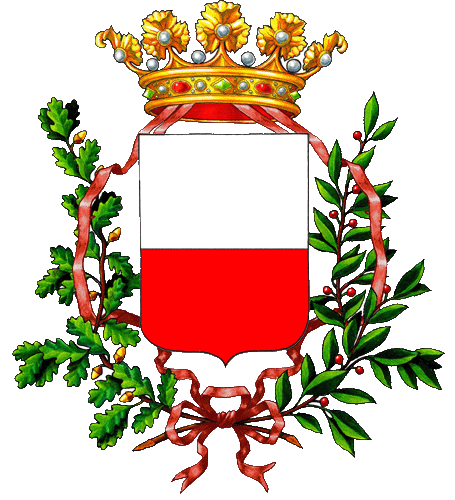 The city of Lucca, the capital of the province with the same name, is an important artistic and cultural center. It’s also been called “the city of 100 churches” for the amount and value of the many religious buildings. In addition to these numerous palaces, there are 130 towers and a beautiful historic bell. The candidacy of Lucca has recently been proposed to UNESCO for inclusion in the World Heritage List. A town with a vibrant economy and a natural tourist destination, Lucca has been able to capitalize on the remarkable artistic heritage accumulated over the centuries.
The city of Lucca, the capital of the province with the same name, is an important artistic and cultural center. It’s also been called “the city of 100 churches” for the amount and value of the many religious buildings. In addition to these numerous palaces, there are 130 towers and a beautiful historic bell. The candidacy of Lucca has recently been proposed to UNESCO for inclusion in the World Heritage List. A town with a vibrant economy and a natural tourist destination, Lucca has been able to capitalize on the remarkable artistic heritage accumulated over the centuries.
Also, the entire historic center has remained largely intact, thanks to the fact that it is completely surrounded by a ring of massive walls over 4 km long. Knowing Lucca does not mean just visiting the many monuments, but also taking advantage of the many different artistic and cultural events that take place throughout the year, such as the internationally renowned Lucca Comics festival, the Photography festival, and many others.
| AREA | Lucchesia |
| TYPE | city of art and capital of the province of Lucca |
| COORDINATES | 43°51′00″N 10°31′00″E |
| ALTITUDE | 19 metri o.s.l. |
| PRODUCTS | wine, china Massagli |
| SPORT | hiking, cycling, bowling, skating, model airplanes, archery |
| BORDERS | Capannori (LU), Massarosa (LU), Pescaglia (LU), San Giuliano Terme (PI), Vecchiano (PT) |
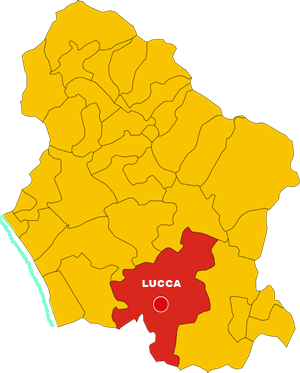 Tourist information
Tourist information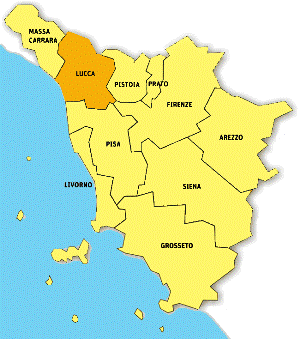
Municipality of Lucca
Via Santa Giustina, 6 – Palazzo Orsetti
Phone: +39 0583 442505
www.comune.lucca.it
APT Agency to tourism LUCCA
Piazza Guidiccioni, 2 – Lucca (LU)
Phone: +39 0583 91 991
WHAT TO SEE
Churches in Lucca
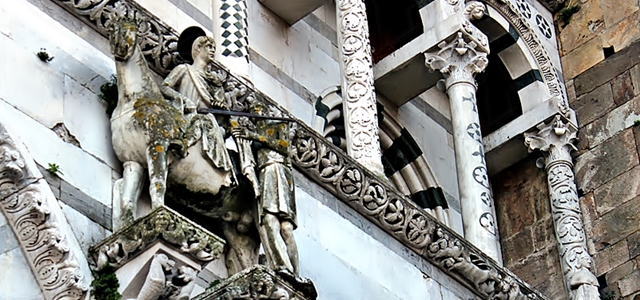 Cathedral of Lucca
Cathedral of Lucca
Cathedral of San Martino - Duomo
 Area: Lucchesia
Area: Lucchesia
Type: Cathedral-Duomo (12th century) – Holy Face
Address: Piazza Antelminelli
Phone: +39 0583 490530
Disabled access: Partial
Legend has it that San Frediano built the first building in the 6th century. It was totally renovated in 1060 by the bishop of Lucca, Anselmo da Baggio, and again rebuilt in the 12th century with the extension and the apse of the church body. The cathedral has always been the destination of a great pilgrimage because of guarding the Holy Face, a wooden cross with the representation of the face of Jesus that, according to tradition, was made by Nicodemus, contemporary of Christ. In the Romanesque façade are reliefs with the martyrdom of St. Regulus and a cycle of months and stories of San Martino. The bezel and input in the architrave are the extraordinary Deposition of Nicola Pisano (circa 1260).
The inside of the cathedral has a Latin cross, with the class divided into three naves; the two sides are topped with galleries with Gothic windows with three lights, while the central one ends with a semicircular apse lit by three large Romanesque mullioned windows.
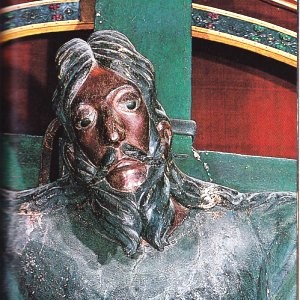 Inside the church is the Madonna and Child Enthroned with Saints by Domenico Ghirlandaio, dating back to 1479. In the third bay of the left aisle, there is a small temple with an octagonal plan, the work of Matteo Civitali (1484), which houses the Holy face. In the sacristy, there is the famous marble sarcophagus of Ilaria del Carretto, made by the sculptor Jacopo della Quercia in 1406.
Inside the church is the Madonna and Child Enthroned with Saints by Domenico Ghirlandaio, dating back to 1479. In the third bay of the left aisle, there is a small temple with an octagonal plan, the work of Matteo Civitali (1484), which houses the Holy face. In the sacristy, there is the famous marble sarcophagus of Ilaria del Carretto, made by the sculptor Jacopo della Quercia in 1406.
The church is located in the Cathedral Museum. Among the most valuable works of the ivory diptych of Arcobindo (6th century), the famous Fiorita Cross of the 15th century and the oldest among the preserved fabrics in the city, the cloth with scenes of the Annunciation.
Church of Santa Maria Forisportam
 Area: Lucchesia
Area: Lucchesia
Type: church (12th – 16th century)
Address: Piazza Santa Maria Bianca
The name is due to the fact that the church was located outside the oldest city wall. The building dates back to the 12th century, but it underwent reconstructions in the 16th. The façade presents three portals on whose lintels appear classical style decorative patterns. Inside the building, there are remarkable paintings: the Saint Lucia and the Assumption of Guercino stand out the most. Unusual for a religious building is the presence of a sundial “dark room.” High up on the eastern wall, there is the lighting hole while the hour line is drawn on the floor when the light beam encounters the hour line and the sun has reached the maximum height, indicating exactly noon.
Church of Sant'Alessandro Maggiore
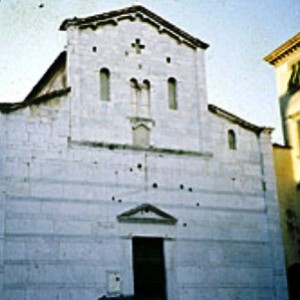 Area: Lucchesia
Area: Lucchesia
Type: early Romanesque church (11th century)
Address: Piazza Sant’Alessandro
Built in the mid-11th century, it incorporates an older church recognizable in the lower half of the façade, and it is entirely covered with white limestone polished slabs. The building is of great historical value because it is a pure example of early Romanesque-Lucchese style, which has remained mostly intact and without substantial changes over the centuries. A basilica with three naves, both the exterior and the interior come together in a coherent simplicity of strict harmony and proportions. Inside, are sculptures dating from the Middle Ages and the underground crypt can be visited.
Church of San Michele in Foro
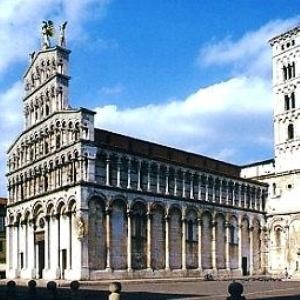 Area: Lucchesia
Area: Lucchesia
Type: Romanesque church (12th century)
Address: Piazza San Michele
The original building was built in the 8th century as the center of the ancient Roman forum. Later on, a hospital and a monastery were added. In 1070, and again in the 12th century, the church underwent reconstructions, which gave it the actual shape of a Latin cross with three naves and semicircular apse. In this period, the bell tower was erected. The façade is decorated with a large marble statue of the Archangel Michael in the act of defeating a dragon with a spear.
Legend has it that, in specific lighting conditions, you can see a green glint coming from the statue, which is supposed be an emerald nestled inside in ancient times and never recovered. Inside, the Corinthian capitals of the columns show a strong influence from Pisan Romanesque style. Among the works of art preserved, are of particular value the Virgin and Child, glazed earthenware by Andrea della Robbia, the Pala Magrini Representative Saints Jerome, Sebastiano, Rocco and Elena, Filippino Lippi, and the relief of the Virgin sculpted by Raffaello from Montelupo.
Basilica of San Frediano
 Area: Lucchesia
Area: Lucchesia
Type: Romanesque church (12th century)
Address: Piazza San Frediano
Legend has it that the original church was built in the 6th century by the bishop of Lucca, Frediano, as confirmed by the remains found under the floor. In the 8th century, a crypt was built to accommodate the religious body, now canonized. In 1112, the building was completely renovated. It dates back to the 13th century mosaic of the façade representing the Ascension of Christ supported by angels. Despite other interventions occurred over the centuries, the church has kept the original medieval aspect: a simple basilica plan of early Christian type, with smooth curtain walls and arches without joints.
The architectural elements are still of Roman tradition, such as colonnades architrave of the façade and the apse, the niche windows, carved capitals. Inside, the valuable fresco Martyrdom of Saints Vincent, Stephen and Lawrence, dates back to the first half of the 12th century. Also noteworthy are the ceiling frescoes and the beautiful baptismal font. The chapel of Santa Zita, one of the two attached to the church, was built in the cemetery where she was buried in 1278.
Church of Santi Giovanni e Reparata
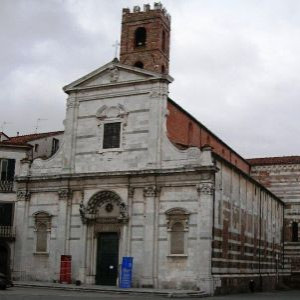 Area: Lucchesia
Area: Lucchesia
Type: Romanesque church (12th century)
Address: Piazza San Giovanni
The original building dates back to the 5th century and was built on the ruins of the Roman era. In the following century, it functioned only as a cemetery, while, from the 8th century onwards, it was used as a church. In the 9th century, the crypt was built where the remains of San Pantaleone were placed. The current building is the result of the restructuring carried out in the 12th century with the expansion of the stairs, to obtain a three-nave church, supported by columns with capitals, with apse and transept. The decorations of the capitals are particularly significant: enmesh figures, masks leafy, harpy eagles and dragons. The façade dates back to the 13th century: the portal with capitals decorated jamb and lintel with Madonna between Angels and Apostles of Villano (1187).
Inside, there are works of art, such as paintings and monuments to Matilda of Canossa and the Archbishop Giulio Arrigoni. The archaeological area below the floor of the basilica shows obvious traces of the early Christian period. At the end of the 17th century, on the left side, the Baroque chapel dedicated to St. Ignatius was built. Designed by Domenico Martinelli, it was completely covered in polychrome marbles with fresco decorations in the dome portraying the Glory of St. Ignatius, attributed to Hippolytus Marracci.
Monuments and places to visit in Lucca
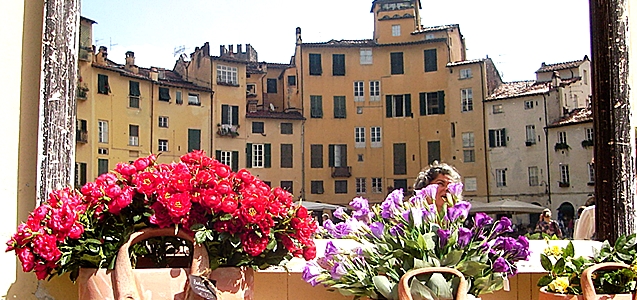 Piazza dell’Anfiteatro
Piazza dell’Anfiteatro
Walls
 Area: Lucchesia
Area: Lucchesia
Type: fortification (16th century)
The various city walls that have been placed over the centuries document the development of the city. The first fortified perimeter was erected shortly after the establishment of the Roman colony. The characteristic rectangular crossed by orthogonal streets stands out in aerial views. In the 12th century, both for the development of the city and for being the primary stage of the Via Francigena (or Romea), it became necessary to provide protection to the villages built outside the Roman walls. The new circle was about 2.45 meters thick and, along its route, Porta dei Borghi and Porta San Gervasio still remain intact (1198).
The new and existing walls were essentially designed to create a major obstacle to the expansionist ambitions of the Grand Duchy of Tuscany. Construction began in the 16th century, but only in 1645, under the guidance of the engineer Paul Lipparelli, the huge labor was finally completed. The result was remarkable and it is currently almost intact. They are the best example in Europe of defensive walls built according to the principles of Renaissance fortification.
The circle, double in width, has a length of over 4 Km. The perimeter is interspersed with eleven bastions and six major gateways. From the northernmost and clockwise they are: Santa Maria (1592), San Pietro (1565), San Donato (1629), Elisa (1811), St. Anne (1910) and San Jacopo alla Tomba (1930). During the 19th century, the city wall was equipped with oaks and turned into a pedestrian promenade. The thickness of the walls is so impressive that in the early years of the 20th century, the upper part was used as a roadway and traffic ring road, the only example in the world of this kind. The walls are now also the stage for shows and events, especially during summer.
Guinigi Tower
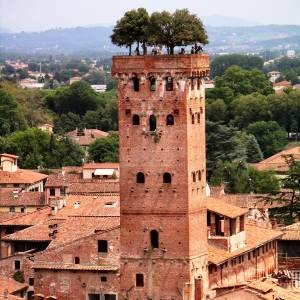 Area: Lucchesia
Area: Lucchesia
Type: fortified residence (14th century)
Address: Via Sant’Andrea, 45
Phone: +39 0583 583086
Hours: from March (9:00 am to 7:00 pm); April, May and October (9:00 am to 9:00 pm); from June to 15 September (9:00 am to 12:00 am); from November to February (9:30 am to 6:00 pm)
Tickets: full € 3.5 – € 2 Reduced
The tower was built in the 14th century as the residence of the Guinigi family, Lords of the city for a few years. The top of the tower is reached by climbing 25 flights of stairs to a total of 225 steps. Along the interior walls, numerous paintings depicting scenes of medieval life were placed. From the top of the tower, you can enjoy excellent views of the city center and the surrounding hills. On top of the tower there is a roof garden, consisting of a walled box filled with dirt, in which seven trees were planted. We do not know exactly the time when the garden was created, but in the 15th century designs the tower is already represented with trees at the summit.
Clock Tower
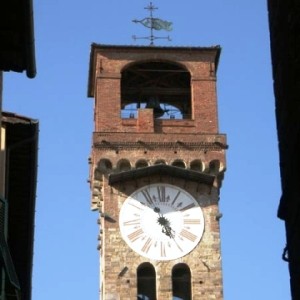 Area: Lucchesia
Area: Lucchesia
Type: fortification (13th century) – open
Address: Via Fillungo
With its 50 meters, it is the highest of the city’s towers. It was built in the 13th century, while in 1390 the clock was installed, goldsmith work by Labruccio Cerlotti. In 1490, it was bought by the government and converted into Torre Civica. In 1754, the new clock mechanism was installed, designed by Louis Simon, who gave the dial Roman numerals and shaped pointer with star in the middle. The clock mechanism is manually wound. In the belfry there are three bells: the largest announces the hours from one to six (according to the Roman use), while the two smaller mark the quarters. Inside the tower, still well preserved, is a wooden staircase with 207 steps.
Ducale Palace
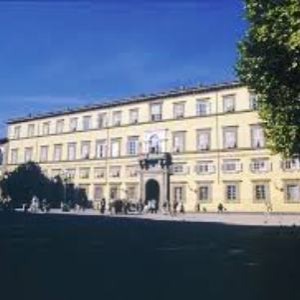 Area: Lucchesia
Area: Lucchesia
Type: Town Hall (16th century)
Address: Piazza Napoleone
In the area occupied by the building the Augsburg Fortress was originally located, residence of Castruccio Castracani, largely destroyed in 1370 during a riot. It was restored in 1401 and became the home of Paolo Guinigi. In 1429, the building was again dismantled and only in the 16th century the Public Palace was built, designed by architect Bartolomeo Ammannati. After being the seat of the government led by Elisa Bonaparte Baciocchi, between 1817 and 1820, the Duchess Maria Luisa of Bourbon ordered the complete renewal of what had become the Ducal Palace.
The interior was completely transformed and the building took on its current appearance, becoming at the same time one of the most beautiful of its kind in Italy. Inside the boardroom a fresco Libertà lucchese, by Pietro Testa. Over the loggia of the guards is the so-called “Loggia dell’Ammannati”, decorated with grotesque and original moldings of the 16th century.
Pfanner Palace
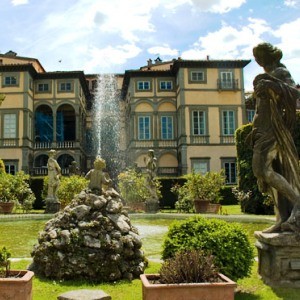 Area: Lucchesia
Area: Lucchesia
Type: fortified residence (14th century) – partially open
Address: Via degli Asili, 33
It was commissioned by the Moriconi family, noble merchants of Lucca, and built in 1660. Overwhelmed by economic failure, the family was forced to sell the building in 1680 to the Controni family, who expanded it. In 1692, it hosted the Prince Frederik of Denmark, passing through Lucca during his “Grand Tour”. The Noble remained in the annals of the city to flirt with the young Lucchese Maria Maddalena Trenta. In 1846, Austrian Felix Pfanner, the brewer, who adapted the entire structure to the production of the drink, purchased the building. In the central hall, frescoed in 1820 by Pietro Paolo Scorsini and containing antique furniture, sacred objects and a wooden statue of the Archangel Michael.
The palace also houses a collection of medical and surgical instruments and ancient medical texts belonged to the doctor Pietro Pfanner (1864-1935). Around the building, there is a garden divided into four grassy areas. The garden has been used as the setting for several films such as “Arrivano I bersaglieri” by Luigi Magni and “Portrait of a Lady” (1996), with Nicole Kidman as the main interpreter. Currently, the building is used for exhibitions and concerts.
Piazza dell'Anfiteatro
 Area: Lucchesia
Area: Lucchesia
Type: historic square
The square is located exactly on the site of an elliptical Roman amphitheater dating back to the 2nd century A.D. The square acquired its present appearance in the Middle Ages when many buildings along the outer perimeter were built. In the 19th century, the square was renovated by architect Lorenzo Nottolini, who completely freed the arena from small buildings and opened the “way of the amphitheater” that traces the outside, the elliptical perimeter. The new space was then used for the local market, called Vettovaglie market, until the first half of the 20th century.
Currently, along the inside perimeter of the square, there are many shops and, within them, the original structures are still visible. Access to the square is through four ports. A curiosity is the cross engraved on a tile placed exactly in the center of the square, at the point where they intersect the axis of the ports.
Teatro del Giglio (Giglio Theater)
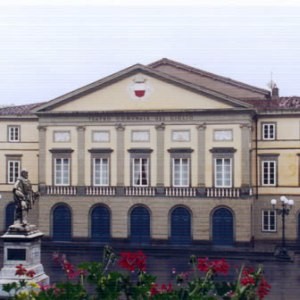 Area: Lucchesia
Area: Lucchesia
Type: 17th-century theater
Address: Piazza del Giglio
Dating back to the 17th century it is one of the oldest public theaters in Italy. With the expansion of theater arts, in 1672 the government of Lucca commissioned its design to Francesco Buonamici. It was inaugurated in 1675 under the name Public Theater. In 1688, it suffered a disastrous fire but, in 1692, the theater was restored according to the original plan. Ceiling frescoes by Angelo Livoratti, and a new stage designed by Silvano Barbati were added. In 1817, restructuring began, carried out by architect Giovanni Lazzarini and engineer Lorenzo Nottolini. The name Teatro del Giglio was chosen by the new ruler of Lucca, the Duchess Maria Luisa of Bourbon.
Among the most significant plays, there is “William Tell” by Gioachino Rossini, performed by a director of exception, the composer and teacher Niccolo Paganini. Later,composer Giacomo Puccini will personally oversee the staging of some of his works, including the Edgar, in 1891. The theater annually organizes a season of operas, a symphony, a ballet and a prose. It also organizes training activities involving various initiatives and workshops aimed at schools, with the staging of shows for young people. Annexed to the theater, there is a library of approximately 4,000 volumes and a video library with recordings of the shows since 1985.
Villa Grabau
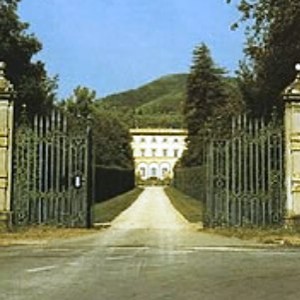 Area: Lucca
Area: Lucca
Locality: San Pancrazio
Type: Villa (16th century)
Dating back to the 16th century, the villa was originally owned by the Diodati family. In the 19th century it was bought by Carlo Ludovico Schwartze, who bequeathed it to his wife, Carolina von Grabau. The building, which is accessed through an avenue lined with geometrically pruned live oaks, faithfully reflects the type of aristocratic residences of Lucca. It is situated in the middle of a garden composed of oval flower beds decorated with pots of lemon trees and decorated with a large circular pool with fountains and statues. The forest includes sequoias, tulip trees and cypresses. In the villa, some scenes of the film “The greatest of all” by Carlo Virzi (2012) were filmed.
Natural Reserves
Serchio River Park
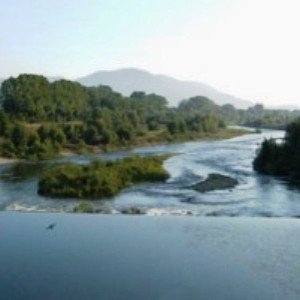 Area: Lucchesia
Area: Lucchesia
Type: nature conservation area
Address: Via Elisa
The park stretches along the banks of the river Serchio. It is possible to walk, go hiking, biking or horseback riding, canoeing or kayaking. There are also recreational areas such as soccer fields, areas for archery, a bowling alley, runs for model airplanes and car modeling, as well as spaces for skateboarding. In the park, there are local flora and fauna, such as kingfishers, herons or mallard. In wooded areas are white poplar, elm, willow and alder. Along one of three routes set up you can admire the magnificent aqueduct built by Nottolini, a great work of hydraulic engineering.
ART AND MUSEUMS
Museums in Lucca
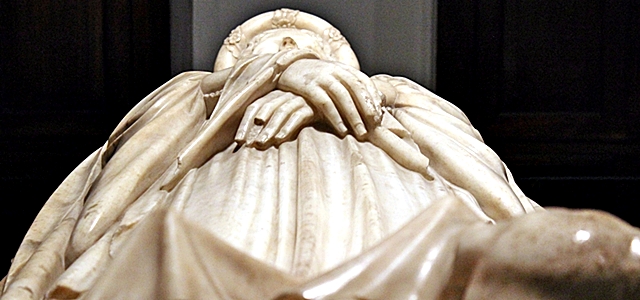 Guinigi wife
Guinigi wife
Giacomo Puccini's house museum
 Area: Lucchesia
Area: Lucchesia
Type: house-museum
Address: Corte San Lorenzo, 8
Phone: +39 053 584028
Site: www.puccinimuseum.it
Email: info@puccinimuseum.it
Opening hours: 10:00 am to 6:00 pm
In 1858 the composer Giacomo Puccini was born on the second floor of the apartment. A major reconstruction has allowed the restoration of the original environments to create a museum that documents the life and works of the musician. Original furniture, objects that belonged to the musician (including autograph scores of youthful compositions), letters, paintings, photographs, sketches, memorabilia and documents, such as a rare draft of the score printing of “La Fanciulla del West”, can be viewed here. In the museum, there is also the outfit of Turandot, made according to the figurine of Umberto Brunelleschi and worn by soprano Maria Jeritza for the first performance at the Metropolitan Opera House in New York in 1926.
There is also the Steinway & Sons piano, purchased by Giacomo Puccini in 1901. It was with this instrument that the musician composed his last opera, Turandot. Currently, the museum also organizes concerts and musical events.
Museum of St. Martin's Cathedral (Duomo di Lucca)
 Area: Lucchesia
Area: Lucchesia
Type: Religious archaeological museum
Phone: +39 0583 490530
Site: www.museocattedralelucca.it
Email: info@museocattedralelucca.it
Opening hours: Monday to Saturday 10:00 am to 6:00 pm and Sunday 10:00 am to 5:00 pm
Tickets: € 4.00 full ticket – € 2.50 reduced
Disabled access: Partial
The cathedral has always been the destination of intense pilgrimage due to the Holy Face, a wooden cross with the representation of the face of Jesus, which, according to tradition, was made by Nicodemus, contemporary of Christ. In the sacristy is the famous marble sarcophagus of Ilaria del Carretto sculpted by Jacopo della Quercia in 1406: it depicts the wife of Paolo Guinigi in sleeping pose, with a dog at her feet. In the church, there is also the Cathedral Museum. Among the most valuable works of the ivory diptych of Arcobindo (6thcentury), the famous Fiorita Cross of the 15th century and the oldest among the fabrics preserved in the city, the cloth with the Annunciation scene.
Museum of Comics and Image
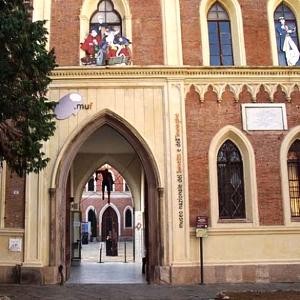 Area: Lucchesia
Area: Lucchesia
Type: Museum
Address: Piazza San Romano, 4
The museum originates from the internationally popular event “Lucca Comics”, which the city wanted to honor with the creation of a permanent collection. In the museum, an overview of the history and evolution of the cartoon, starting with the debut of its kind in Italy: Frugolino, Novellino, Corriere dei Piccoli. There are also spaces dedicated to authors as Antonio Rubino. They are also on display, as some of the first issues of the Italian magazine of Mickey Mouse.
Some rooms are dedicated to comics and newer designers, including Luciano and Federico Pedrocchi. Finally, some periodicals in very successful Italian Comix, such as Tex and Diabolik, and a room dedicated to Walt Disney and Jacovitti. Renzo Pardini and Roberta Cross have created the sculptures inside the museum and the sets in collaboration with the authors of comic book characters. Also present is an interactive course that includes “The houses where dreams live”, in which Lupo Alberto shows how a comic book is made, the Disney Hall and the Art Attack Lab.
National Museum of Villa Guinigi
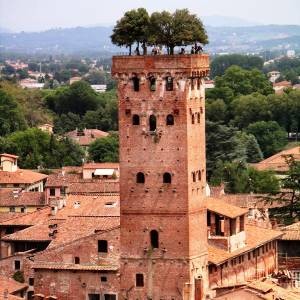 Area: Lucchesia
Area: Lucchesia
Type: archaeological museum
The museum is located in the villa built by Paolo Guinigi, lord of Lucca, in 1413. The collections on display are quite varied. We find anything from prehistoric, to Etruscan and Roman, as well as paintings, sculptures, vestments and fabrics from the Middle Ages to the 18th century. Noteworthy is the Cross painted by Berlinghiero Berlinghieri, two Madonnas and Child by two tabernacles attributed to Donatello, the Pietà by Matthew Civitali, God the Father in glory between the holy Mary Magdalene and Catherine of Siena and Our Lady of Mercy of Fra’ Bartolomeo (1508). Finally, exposed instruments and medical equipment from the ancient hospital of San Luca and various measuring instruments from the 18th-19th centuries.
Picture Gallery of Mansi Palace
 Area: Lucchesia
Area: Lucchesia
Type: Art museum
It is situated inside the Palazzo Mansi, dating back to the 16th century and was restored in baroque style. The building has preserved the original furniture, as well as its paintings and tapestries on the walls. Of particular interest is the Bridal Chamber, with the original alcove and embroidered silk fabrics of the 18th century. In the museum are works of the 19th century by Pompeo Batoni, Nocchi Bernardino, Stefano Tofanelli.
Also instruments and antique textiles such as frames, vintage clothing patterns, religious vestments of the 16th -17th -18th centuries. The paintings are divided into four rooms, depending on the style and era. Of particular value are the works of Ghirlandaio, Veronese, Titian, Andrea del Sarto, to name only the most important painters.
Botanical Garden
 Area: Lucchesia
Area: Lucchesia
Type: Villa (16th century)
Address: Via del Giardino Botanico
Opening hours: 3 November to 19 March: from Monday to Friday (9:30 am to 9:30 pm) on reservation – 20 March to 2 November (10:00 am to 5:00 pm) in July and August (10:00 am to 7:00 pm)
A scientific institution founded in 1820 by the Duchess Maria Luisa of Bourbon home to hundreds of plant species. Set up in the 16th century as a garden of medicinal plants, in the 19th century it was modified by the insertion of important tree species. Most of the trees and shrubs, for the most exotic, are located in a specific area called “arboretum”. Some wood species were introduced in the first half of the 19th century. The cedar of Lebanon, planted by Paul Foxes in 1822, with its 6 meters in circumference, 22 meters high and a large canopy is considered the symbolic plant.
The sector Hortus sanitatis consists of herbal medicines, about 500 species originating from different continents. The wild plants sector comprises a set of plants for food, especially those typical of the Lucca area. Another section is dedicated to water plants that are cultivated in the pond and in the oldest octagonal pool. Among the species found, there are the white water lily, the royal fern and sundew (Drosera rotundifolia). The so-called succulents, typical of deserts, are within the monumental greenhouses.
Worth mentioning are the camellias and rhododendrons. The first imported in the 18th century, they flourished due to the favorable climatic conditions. Lucca became one of the most important centers with a large number of enthusiasts and farmers. The Botanical Garden has a library of 2,000 volumes among which there are some from the 17th and 19th centuries. The Botanical Museum collects various herbaria and there is also a xylological collection of different tree species. The pomological collection, made up of models in plaster of fruit grown in the countryside of Lucca in the 18th and 19th centuries is also very old and significant.
What to do
Events
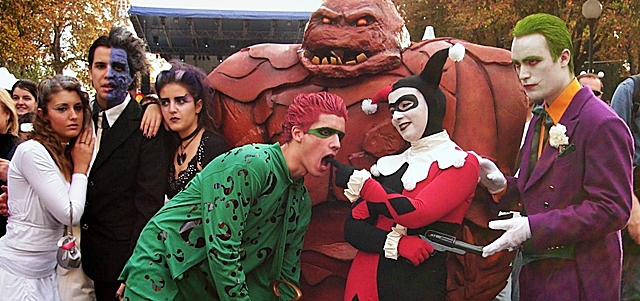 Lucca Comics
Lucca Comics
Exaltation of the Holy Cross Fest
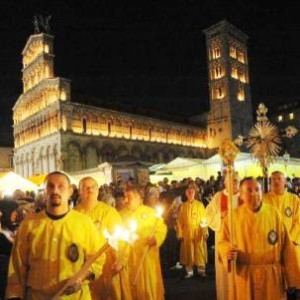 Type: religious festival
Type: religious festival
When: September 13
It’s a long procession to the Church of San Martino (Duomo di Lucca) in honor of the Holy Face. The procession takes place through the streets of the historic center, illuminated by thousands of candles. The procession includes marching bands, archers and people in medieval clothes.
Palio della Balestra
 Type: sports folklore
Type: sports folklore
When: July 12
On the occasion of the Feast of San Paolino, patron of Lucca, a traditional contest between crossbowmen representing citizens is organized. The archery contest takes place under the rules of 1443, the oldest shooting regulation in Europe.
Medieval Fair of the Holy Cross
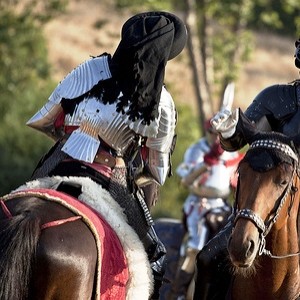 Type: folklore – reenactment
Type: folklore – reenactment
When: September
It is a historical re-enactment that takes place in the basement of St. Peter’s bastion, under the walls of Lucca. The event revives the ancient Fair Market. There are stalls of artisans and merchants, musicians, jugglers and street performers.
Lucca Comics & Games
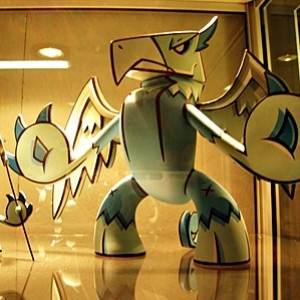 Type: animation
Type: animation
When: late October
It is one of the most important international events dedicated to comics, animation, games and video games.
Lucca Film Festival
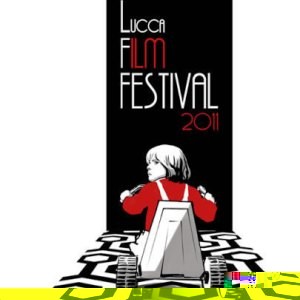 Type: film
Type: film
When: October
The festival alternates screenings, exhibitions, conferences, lectures and practical workshops devoted to experimental and independent cinema.
Lucca Digital Photo Fest
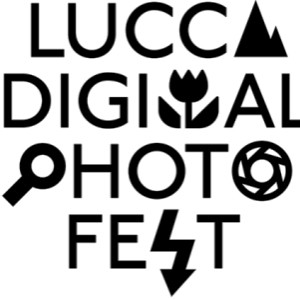 Type: Photo
Type: Photo
When: end of November
The festival includes a large exhibition of photojournalism, the presence of well-known international photographers, PHOTOCAFE, workshops and portfolio reviews.
Lucca Summer Festival
 Type: Music
Type: Music
Period: July
The festival hosts artists of international renown.
Puccini and his Lucca
 Type: Music
Type: Music
When: all year
The Basilica of St. John hosts the Puccini Festival, aimed at helping professional interpreters. The event schedule includes a different program every evening.
ITINERARIES
Itineraries around Lucca
Nature trail
Two nature trails are available: the first of about 11 Km between the towns of Ponte San Quirico and Ponte San Pietro in Sant’Anna and the second of about 11 Km between Ponte San Quirico and Ponte a Moriano. Both walks lead through hilly areas and small towns.
River route
The route leads from Ripafratta up to the sources of the Nottolini aqueduct and along the Ozzeri canal. It offers an appealing view of the wetlands and agricultural fields.
Historical itinerary
It starts from the slopes of the Monti di Vorno where the water reservoirs of the Nottolini aqueduct are located, and continues along the arches of the San Concordio temple.
CULTURE
History of Lucca
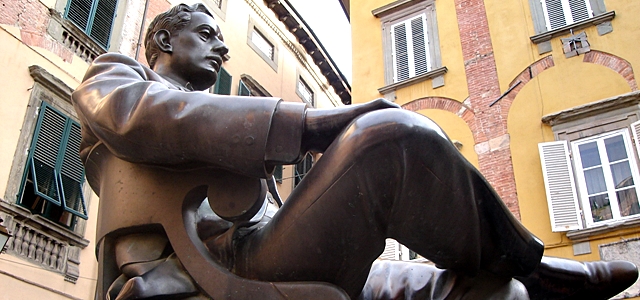 Giacomo Puccini musician
Giacomo Puccini musician
Two thousand years of history
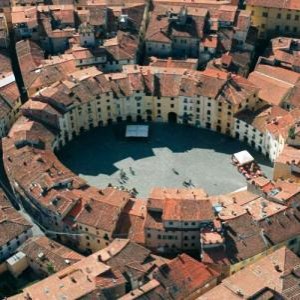 Lucca became a town in 1119. At the beginning of the 14th century, two people in particular changed the political scene. The first one was the Ghibelline Uguccione Faggiola, an imperial vicar in Pisa, who, from 1313, extended control over Lucca. But the leader’s rough methods tired the city, and, two years later, an uprising of the population drove him away. Almost inevitably, he was succeeded by the best of his commanders, the Lucchese Castruccio Castracani of Antelminelli, acclaimed Captain General.
Lucca became a town in 1119. At the beginning of the 14th century, two people in particular changed the political scene. The first one was the Ghibelline Uguccione Faggiola, an imperial vicar in Pisa, who, from 1313, extended control over Lucca. But the leader’s rough methods tired the city, and, two years later, an uprising of the population drove him away. Almost inevitably, he was succeeded by the best of his commanders, the Lucchese Castruccio Castracani of Antelminelli, acclaimed Captain General.
Castruccio soon made Lucca a strong antagonist to the expansion of Florence. Then, alternating political agreements and military actions, he secured most of the Tyrrhenian Sea coast. The tension with Florence rose until the inevitable war that ended with a crushing defeat of Florence in 1325. Castruccio held power until 1328, the year of his untimely death. The period that followed was chaotic.
Eventually, it was Milan that took control of Lucca (1335), giving rise to more than twenty years in which the city was treated as a colony. It will take the descent in Italy of a monarch, Emperor Charles IV, for Lucca to be an independent republic, along with payment of 100,000 gold florins. In 1370, Lucca experienced a great economic and building momentum. The height was reached in 1400 when Paul Guinigi was appointed Captain of the People and Lord of Lucca. However, in 1425, the military weakness of the city was well known to Florence that began a series of military operations against the city. The campaign ended with the siege of 1429.
The following year, Paolo Guinigi was deposed by a revolt and the Republican government was restored. Lucca remained independent until 1799 when Napoleon’s army occupied the territory. The alternation of military events caused a period of uncertainty and numerous changes, which ended only in 1805. That same year, the Principality of Lucca and Piombino were formed and assigned to Felice Baciocchi, husband of Elisa Bonaparte, Napoleon’s sister, although it was she who actually governed the state.
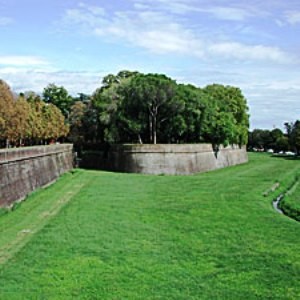
In 1815, after the final surrender of Napoleon, the Congress of Vienna agreed on a new structure for the city. Lucca, transformed into the Duchy, was assigned to Maria Luisa of Parma Bourbon, who arrived in 1817. In 1824, after her death, succeeded by her son Carlo Ludovico Chei, who remained in office until 1847 when he chose to abdicate. The Duchy of Lucca was then integrated into the Grand Duchy of Tuscany and followed its fate until the unification of Italy in the 19th century.
Curiosity
Matilde di Canossa
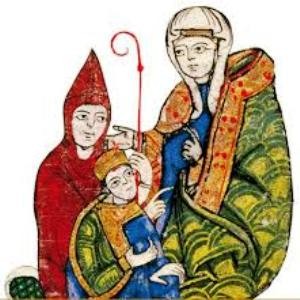
Legend has it that the pious Countess Matilde of Canossa repeatedly asked Pope Gregory VII to be able to celebrate Mass, despite being a woman. The pope granted the request on the condition that the Countess built 100 churches. The noblewoman missed the set goal: in fact, Matilde managed to build 99 churches, most within the city walls, thus giving Lucca its nickname of “city of a hundred churches.”
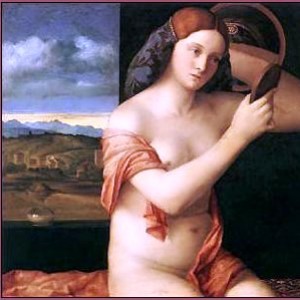 Legend of the pond
Legend of the pond
The pond of the Botanic Garden is linked to a legend that dates back to the 17th century. The protagonist was Lucida Mansi, a vain noblewoman who had sold her soul to the devil in exchange for eternal youth. Her life ended when the Devil himself, who wanted her to pay her debt, came on a fiery chariot and pulled her into the mirror of water. Legend has it that this occurred on the night of 14 August 1623. It is said that, on full moon nights, you can see her reflected in the pond.
GASTRONOMY
Typical Food
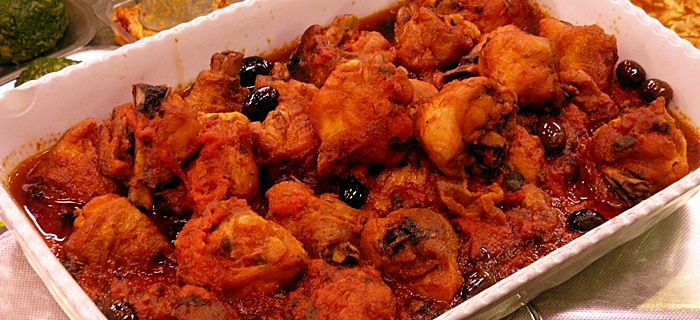
Coniglio alla Cacciatore
Lucca cuisine is linked to its agricultural traditions and based on a variety of raw materials and local agricultural products, as well as it fertile countryside. Among the most popular dishes, there are:
Tortelli con ripieno di carne (Meat-filled Ravioli)
Tortellata pasta (pasta served with a sauce of tomatoes, chard, ricotta and Parmesan)
Garmugia (soup of spring vegetables such as peas, broad beans, artichokes and asparagus)
Zuppa lucchese di magro – Lucca meatless soup (typical Friday dish, whose main ingredients are cabbage and wild herbs)
Coniglio alla cacciatore (stewed rabbit)
Liver pork garfagnina (flavored with fennel and bay leaves)
Buccellato (cake shaped like a donut stuffed with anise and raisins)
Pasimata (Easter cake)
Torta co’ becchi (sweet pastry, usually with chocolate, cream or herbs, characterized by an outer ring of pastry folded so as to take the form of horns)
Typical Products
Biroldo e mallegato (blood-based pork sausage and pork offal)
Wine – Colline Lucchesi DOC
Biadina (herbal liqueur)
China Massagli (herbal liqueur)









